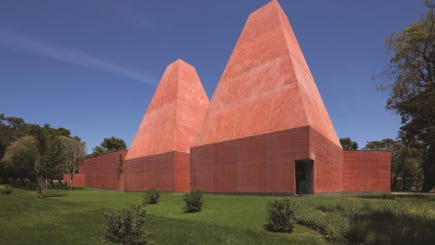Our plan to take the train into Lisbon today was canceled due to rain. Instead, we visited Casa das História Paula Rego an art museum just a few blocks from our home.
Striking Building
Though I must admit I don’t find the building particularly attractive, it certainly is striking. The first time we passed it, just behind the park that we often walk through when returning from our beach walks, we both wondered what it was. The deep red cement facade and sharp unadorned angles seemed out of place. I have since learned that it was designed by an acclaimed Portuguese architect, Eduardo Souto de Moura and that his choice as the architect was made by the artist whose works it houses.
Paula Rego
Dame Maria Paula Figueiroa Rego, is a Portuguese-born visual artist who studied and lives in London. Born in 1935, she spent her early years living with her grandmother in and around Lisbon. Her parents were Anglophiles and chose to send her to the English-language St Julian’s School in Carcavelos as a child. While being raised in a devoutly Catholic country, the school was Anglican and resulted in Rega referring to herself as “sort of a Catholic”. She attended finishing school and college in the U.K. and it was there that she met her husband Victor Willing who was also an artist.
Rego is a feminist and many of her works speak to women’s rights and abortion rights. Most of the museum displays a rotating collection of her (and her husband’s) work. However, currently, one wing is dedicated to an exhibit called Religious Art in the Feminine featuring the 17th-century painter Josefa de Óbidos. We were directed to begin our journey through the museum with her exhibit which focused on Teresa of Ávila (also known as Saint Teresa of Jesus).
While the paintings depicted traditional religious themes, it seemed to me that a disproportionate number of the figures in the paintings were women. We then walked into the next room which displayed Rega’s work … an interesting juxtaposition, to say the least.
In 2002, Rego was commissioned to paint “Scenes from the Life of the Virgin Mary” for the Chapel of Nossa Senhora de Belém, at the presidential palace (Palácio de Belém). Paula Rego said:
It was always men who painted the Life of the Virgin, and here it is a woman. She has a different point of view. Because people identify much more with her story. In fact, this is a homage to, and a history of, the Vigin’s life.
Over her 50-year career, Rego has worked both in two dimensions (paint, pastels, and etchings) and three dimensions. The three-dimensional piece above includes paintings and sculpture to form an oversized oratory. Commissioned as part of an exhibit called “Songs of Innocence, Experience, Ambivalence” she portrays:
The tragic lives of children left to their own fate from the moment of their violent conception (at the top of the left side panel) until they are settled in this home that was to welcome them.
Artistic Process
While her work is quite varied, what I found most interesting was the display of her process. Several rooms included the original pencil sketches ripped from her sketchbook. These were followed by small pastel or water-colored studies, showing gridlines that would later enable her to move that portion to scale in the final piece. It was almost as if you were observing her in her studio as she works through the process of making art.









Dark and quirky artist. And she is still alive. Good Find!
What a find! Fascinating and I love the architecture of the building. Thanks for sharing, when I come up for air I am going to look at the artists, museum and architect and building in more depth prior to my actual visit one of these days! Stunning....